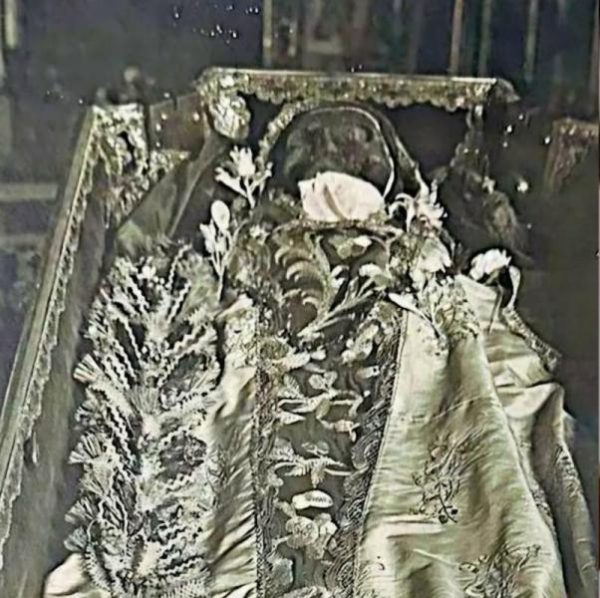St. Teresa of Ávila (also known as St. Teresa of Jesus) was a Spanish nun and later a Roman Catholic saint born on March 28th of 1515. On October 4th of 1582, she died at the age of 67. A few weeks ago on August 28th, St. Teresa was taken from her place of burial at the Basilica of Santa Teresa in Alba de Tormes, Spain. Having opened her coffin with ten different keys, the Diocese of Ávila in Spain opened the saint’s coffin and discovered that her body was in the same condition as it was in 1914. I will get to the meaning of all of this in a bit, but here’s some background on St. Teresa.
WARNING: A picture of St. Teresa’s incorrupted body is shown below. It’s a little frightening at first, but fascinating.
St. Teresa was born in Ávila, Spain in the early 16th century. It is assumed that in her 20s, she joined the Carmelite Convent. Sources are torn between whether St. Teresa chose to join the Carmelites or whether her father forced her to (some sources say her father did not like her religious activities, some say he sent her to the convent). Shortly after becoming a nun, she fell extremely ill (she had many life-threatening health problems throughout her life), causing her to take a break from her religious duties. In her 40s, a priest came to her and encouraged her to return to religious life. In her return, she found solace in her pain, despite not liking praying. After a while, she came around to it and devoted her life to God. St. Teresa, later in her life, is known for “[reforming] the Carmelite Order,” says the New York Times. The Spanish nun thought that the environment she prayed in wasn’t following the traditional norms of the Carmelite Convent. So, she and a few sisters started their convent where participants would live simple lives, creating the Convento de San José. I emailed Pauline Bedard, President of the Secular Order of Discalced Carmelites in Peabody, MA, to hear her thoughts on St. Teresa’s impact on the Carmelites. She wrote, “During St Teresa’s time convents were often very large. Class distinctions were present with women from well to do families having their servants with them in the convent! There were always many visitors… Teresa wanted to get back to basics. She thought communities should be small (12 sisters). [There] should be houses devoted to prayer- especially praying for the Church and for priests.” St. Teresa is also credited with the founding of the Discalced Carmelites, according to the Discalced Carlemiltes’ website (discalced is a term referring to nuns or friars go chose to wear sandals or go barefoot – showing their ways of a simple life.). The Discalced Carmelites followed uncomplicated rules, living in poverty and service to God. In 1582, she succumbed to her illnesses and died at the age of 67. Pope Gregory XV canonized Teresa in 1622. Nearly three and a half centries later, in 1970, Pope Paul VI announced that St. Teresa would become the first female Doctor of the Church. Doctors of the Church are saints recognized by the Catholic Church for their devotion and contributions to Catholicism. Catholic Saint Medals says that St. Teresa is “the patron saint of those who suffer from headaches and migraines, those who are ill, people ridiculed for their religious faith, and Spain.”

Back to the reason why I’m writing this article: St. Teresa’s coffin was opened for the first time since 1914. In 1914, her corpse was deemed incorrupt by scientists at the time. “Incorrupt” is a term widely used for saints whose bodies have gone through little or no decomposing. Saint Padre Pio, St. Bernadette of Lourdes, and St. Clare of Assisi are just some of the saints who are incorrputed. In late August, scientists opened her coffin to study her body to understand what health complications she had at the time of her death. After seeing St. Teresa’s face and her foot (those were the only body parts exposed), experts and analysts compared her body to the pictures taken of her in 1914. They realized very quickly that her body looked the same as it did then. The Diocese says that her body has maintained its form. According to a press release, Father Marco Chiesa of the Diocese reported that “…The uncovered parts, which are the face and foot, are the same as those they were in 1914… There is no color, there is no skin color, because the skin is mummified, but it is seen, especially in the middle of the face.” * Whether incorruptibility is done through a process of science or rewarded to a saint due to their devotion to God, the process is incredible. When asked about St. Teresa being incorrupt, Pauline Bedard said that she is “certainly not surprised by this. Through her life of intense prayer she reached great heights of holiness. She loved God with every fiber of her being and longed to see others love Him as well. Her writings give testimony to this.”
* Translated press release from the New York Post.






















Bella Kim • Sep 13, 2024 at 6:25 pm
Wow this is so interesting, Shannon! You’re so good at the historical women figure articles.
Shannon Raneri • Sep 13, 2024 at 6:39 pm
Thank you so much, Bella! This means a lot. Thank you for reading The Viking Times!
Theresa McCarron • Sep 13, 2024 at 11:44 am
Interesting reading. Thank you.
Shannon Raneri • Sep 13, 2024 at 8:44 pm
It is very interesting! Thank you for reading!
Mark W Dixon • Sep 13, 2024 at 9:58 am
Breathtaking.
They say Edward I’s body was pretty sound once they dug him up in the 18th century. It’s amazing what an airtight coffin will do.
Shannon Raneri • Sep 13, 2024 at 10:04 am
It is absolutely incredible. Thank you for reading!
Kayla Dame • Sep 13, 2024 at 9:30 am
Sooooo fascinating!! I learned something new today–” “Incorrupt”. (:
Shannon Raneri • Sep 13, 2024 at 10:04 am
I’m glad I could contribute to that new knowledge. Thank you for reading!